
PUMPA - SMART LEARNING
எங்கள் ஆசிரியர்களுடன் 1-ஆன்-1 ஆலோசனை நேரத்தைப் பெறுங்கள். டாப்பர் ஆவதற்கு நாங்கள் பயிற்சி அளிப்போம்
Book Free DemoCollenchyma:
- Collenchyma word derived from Greek (Kolla means glue).
- The term collenchyma was coined by Schleiden \((1839)\).
- Collenchyma is a living tissue found beneath the epidermis.
- Cells are elongated with unevenly thickened non-lignified walls.
- Cells have rectangularoblique or tapering ends and persistent protoplast.
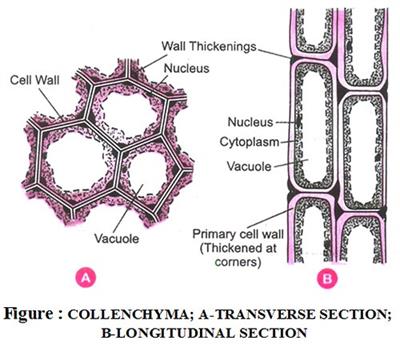
Collenchyma
Location: It is located in the leaf stalks below the epidermis and leaf midrib. It is absent in dicot roots, monocot plants and underground parts.
It has a central vacuole and peripheral cytoplasm with a nucleuselongated and unevenlythickenedat the corners because of pectin deposition. Intercellular spaces between cells in this tissue is tiny.
Functions of Collenchyma:
- It gives flexibility and elasticity to the plant and prevents the tearing of leaves.
- It provides mechanical support for the plant.
- This tissue enables parts of the plants, such as tendrils and stems of climbers, to bend easily without any breaking.
Sclerenchyma:
Location: In stems, around vascular bundles, in the veins of leaves, in the hard covering of seeds and nuts.
- The cells of this tissue are dead cells and act as a skeleton in plants.
- Cells are long and narrow in appearance.
- They do not possess a nucleus and cytoplasm at maturity. i.e., no living protoplasts at maturity.
- It is the most hardened plant tissue. This tissue's cell walls are uniformly thickened due to lignin (i.e. Lignified), which often provides no intercellular spaces between cells. E.g., Jute and coir fibres are rich in lignin.
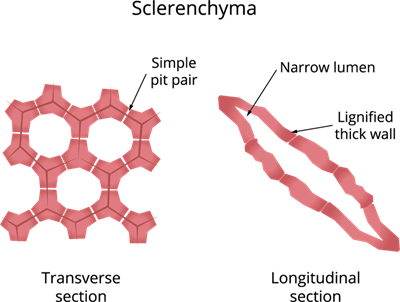
Sclerenchyma cells are of two types, viz., Fibres and sclereids.
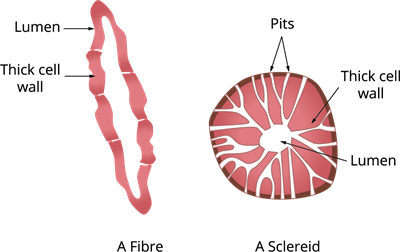
Fibres and Sclereids
Fibres:
- Fibres are very long, narrow and elongated sclerenchymatous cells, usually with pointed ends.
- Cell walls are thick and lignified.
- Fibres are abundantly found in many plants. The average length of fibres is\(\ 1\) to \(3\) mm; however, in plants like Linum usitatissimum (flax), Cannabis sativa (hemp) and Corchorus capsularis (jute), fibres are extensively longer ranging from \(20\) mm to \(550\) mm.
- Lumen is large as compared to the sclereids. In the thick wall, both the sclereids and fibres are present in thin areas called pits. Pits are narrow and unbranched.
- These fibres are present in bundles and provide strength and hardness.
- Jute, a sclerenchymatous tissue, is used in making of rope and fabrics.
Sclereids:
- Sclereids are widely distributed in plant body.
- They are usually broad, may occur in single or in groups.
- Sclereids are isodiametric, with lignified walls.
- Pits are prominent and seen along the walls.
- Lumen is filled with wall materials.
- Sclereids are also common in fruits and seeds. These are also called grit cells or stone cells. These are small cells where the lumen is so tiny due to higher thickening of the cell wall as in drupe fruit (mango, coconut, walnut).
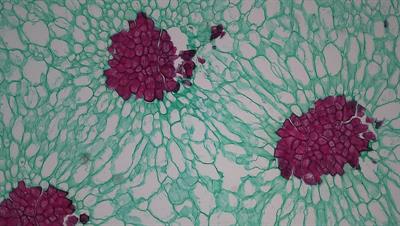
Sclereid cells in pear (Pyrus) fruit under the microscope
Functions of Sclerenchyma:
- This tissue gives very rigid mechanical support to plants so that plants are hard and stiff. For example, the husk of the coconut is made up of sclerenchymatous tissue.
- It is used to manufacture ropes, mats and certain textile fibres.
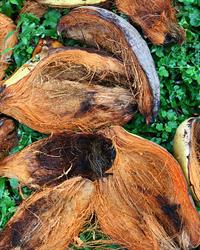
Husk of coconut
Reference:
https://www.flickr.com/photos/144872528@N06/29092177320/in/photostream/
https://commons.wikimedia.org/wiki/File:Sclereids_in_Pyrus_pear_(36452689110).jpg